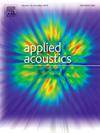Tool wear detection using novel acoustic emission features and a two-stage Mann-Whitney U test
IF 3.4
2区 物理与天体物理
Q1 ACOUSTICS
引用次数: 0
Abstract
Accurate detection of tool wear is a critical challenge in manufacturing due to the complex and nonlinear nature of acoustic emission (AE) signals generated during machining. Conventional methods, including machine learning and deep learning, often fail to detect the subtle changes associated with early tool wear and suffer from a lack of explainability in their decision-making processes. This paper introduces three novel AE features: rank-based entropy, fractal geometry indicator, and chaos quantifier. These features are specifically designed to capture the intricate dynamics of AE signals that traditional methods overlook. To validate the discriminative power of these features, a two-stage Mann-Whitney U test is employed, combining the new features with other advanced AE features to differentiate between worn and unworn tools. Experimental results from milling and drilling machine tests show that the proposed approach significantly improves detection sensitivity, accuracy, and interpretability compared to existing methods, providing a more robust framework for tool wear detection. The source code for this paper is available at: https://github.com/thuan-researcher/novel-ae-features-two-stage-mu.
使用新型声发射特征和两阶段Mann-Whitney U测试进行工具磨损检测
由于加工过程中产生的声发射(AE)信号的复杂性和非线性,刀具磨损的准确检测是制造中的一个关键挑战。包括机器学习和深度学习在内的传统方法通常无法检测到与早期工具磨损相关的细微变化,并且在决策过程中缺乏可解释性。介绍了三种新的声发射特征:秩熵、分形几何指标和混沌量词。这些特征是专门为捕获传统方法忽略的声发射信号的复杂动态而设计的。为了验证这些特征的判别能力,采用了两阶段Mann-Whitney U测试,将新特征与其他高级AE特征相结合,以区分磨损和未磨损的工具。铣床和钻床的实验结果表明,与现有方法相比,该方法显著提高了检测灵敏度、精度和可解释性,为刀具磨损检测提供了更强大的框架。本文的源代码可从https://github.com/thuan-researcher/novel-ae-features-two-stage-mu获得。
本文章由计算机程序翻译,如有差异,请以英文原文为准。
求助全文
约1分钟内获得全文
求助全文
来源期刊

Applied Acoustics
物理-声学
CiteScore
7.40
自引率
11.80%
发文量
618
审稿时长
7.5 months
期刊介绍:
Since its launch in 1968, Applied Acoustics has been publishing high quality research papers providing state-of-the-art coverage of research findings for engineers and scientists involved in applications of acoustics in the widest sense.
Applied Acoustics looks not only at recent developments in the understanding of acoustics but also at ways of exploiting that understanding. The Journal aims to encourage the exchange of practical experience through publication and in so doing creates a fund of technological information that can be used for solving related problems. The presentation of information in graphical or tabular form is especially encouraged. If a report of a mathematical development is a necessary part of a paper it is important to ensure that it is there only as an integral part of a practical solution to a problem and is supported by data. Applied Acoustics encourages the exchange of practical experience in the following ways: • Complete Papers • Short Technical Notes • Review Articles; and thereby provides a wealth of technological information that can be used to solve related problems.
Manuscripts that address all fields of applications of acoustics ranging from medicine and NDT to the environment and buildings are welcome.
 求助内容:
求助内容: 应助结果提醒方式:
应助结果提醒方式:


